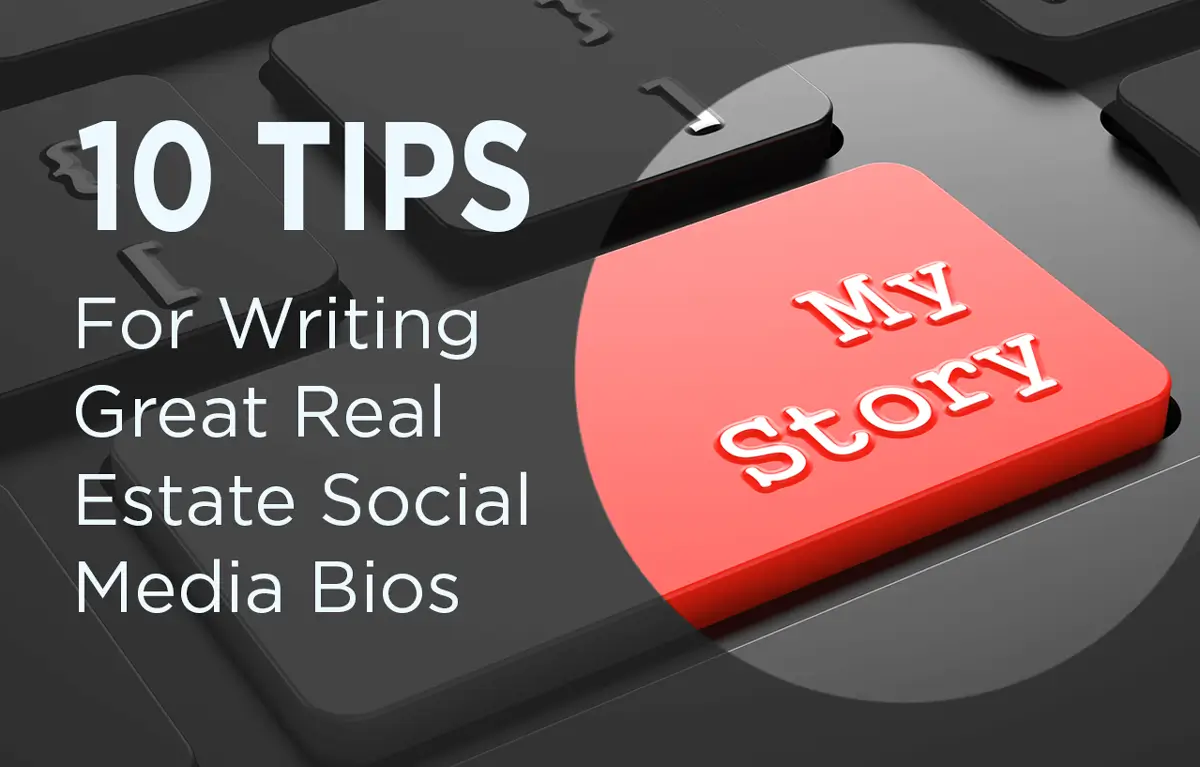A recent study by Business Insider revealed that Americans spend more time on social media than any other major Internet activity, which amounts to about 27 percent of every hour. And if you think this applies to just young people, reconsider: 72 percent of 30–49 year olds, 60 percent of 50–60 years olds, and 43 percent of those 65+ are active on social media sites.
What does this mean for your business?
Your prospective leads and clients are already using social media consistently, and many of them are using social media as search engines in their home buying and selling processes. More than ever, consumers want to get as close to a business as possible before committing to doing business with them.
As they come across various agent profiles, they’ll often check out your bio before sifting through your content, and many social sites make your bio the most prominent feature on your page.
Modern consumers care about brand personality, but also things like your personal interests and how savvy you are in your industry. Use these tips to create a real estate social media bio that sets a strong first impression.
How to Write a Great Social Media Bio
You’re probably thinking “I already have a social media bio,” but the average professional brand on social media stops after the basics like title and contact information. While those are important, they don’t automatically set you apart from the many other real estate agents out there who are also using this tactic.
Your bio is your opportunity to showcase your personality to leads and clients. According to Buffer, it’s, “an introduction — a foot in the door so your potential audience can evaluate you and decide if you’re worth their time.”
Whether it’s short or long, after a quick glance at your bio, a social media user should feel like they know you. Condensing your great features into a small number of characters isn’t easy, but consider these 10 tips:
1) Focus more on actions than character.
This sounds a bit counterintuitive, but prospective clients are not nearly as interested in your needlepoint collection as they are in the fact that you’ve sold a record number of properties for your brokerage. Show you’re a hardworking agent who gets results by describing the professional attributes that set you apart. Keep it less self-referential by using lots of action verbs, as you would in your real estate resume, and by being as specific as possible with your details.
2) Write in the first person.
This bio is going to be more personal than the full agent bio on your website. Be authentic here, speak in the first person, and offer things you care about. If you’re having trouble figuring out what to write, use some prompts to get you going.
3) Focus on keywords.
Use the same principles you’ve taken from your keyword research to craft bios that not only highlight the terms that impress buyers and sellers, but also ones that will optimize your page so when users search key terms in the social platforms, your profile is more likely to pop up in the results.
4) Avoid buzzwords.
Users expect that your social media bio will be unique, so your language must represent original thoughts. Don’t use some of the most overly used terms and don’t give yourself vague titles like “guru” or “maven,” as 181,000 users on Twitter do.
5) Use humor.
Emotional messaging works to help you connect with social media followers, and positive emotions toward brands yield greater influence, so it’s to your benefit to showcase humor. Make sure it comes off as natural and is authentic to how you’d be in person.
6) Offer a value proposition.
The value proposition is all about telling your reader what they can expect from you.
If you have a history of success, include a business value proposition, or your value may simply be the content that you’ll be putting on your business social media page that will helpful and relevant to your leads.
Focus on giving your reader a hint of what you value and what they can expect to read once they hit the follow button. Bonus points if you can fit in a call to action (CTA) that offers a way for them to engage with your content, like a free download or an invite to Tweet or email you directly.
7) Be consistent.
Truly effective personal brands maintain a strong sense of brand personality everywhere, so it’s important that what you do in your bio should be consistent across channels.
Essentially, you want to provide the same information in different ways: Twitter you’ll most likely use short phrases, where on Facebook you’ll write a cohesive paragraph, and on Google+ you’ll spend your time highlighting successes and link to your resources — but each of these should feel connected in both information and style.
Don’t solely focus on selling properties in one and solely focus on being a family man in another: Define your personal brand and use it consistently everywhere.
8) Make it as concise as possible.
Most likely you’ve looked at your website bio and tried to rewrite it in fewer words, making it still too long for the average social media bio. Even if a social networking site gives you unlimited space to write your bio, only offer the most important information.
This bio is a teaser — a simple hello and introduction for someone who is considering following you. Take what you have and see how you can say the same things in less space. Here are some ways to cut it down:
Be creative with words.
With limited space, turn a sentence into a few words.
- “I enjoy working with luxury properties” can be “lux property lover.”
- “I’m an agent who loves helping clients find the perfect home” can just as easily be “Perfect home finder… or I don’t sleep!”
With longer bios, use a dictionary or thesaurus to help you vary your word choice throughout the bio, but always make sure to use words you would actually say in real life.
Prioritize
Take the characteristics you’ve listed and pare them down so you can focus on the top ones that will fit into that space. Does your consumer need to know you’re a dog lover? Maybe. But have you already listed that you’re a coffee addict, cake enthusiast, and yogi? Focus on highlighting the essential information you want a lead or client to take away after reading it.
Show it to a close friend.
After writing a bio, it can often feel like you sound cheesy, formulaic, or just simply trying too hard. Show your bio to a trusted friend or colleague and have them determine whether it really sounds like you. Then, reread it and take out anything that doesn’t help develop your story.
9) Offer striking photos.
Visual storytelling is powerful, and your social media banner photo and profile photo are the first things users will see when coming to your page. Create striking imagery that fits with the written bio you’ve created, whether that’s a landscape from you area, a pretty logo you’ve designed, or you participating in one of the passions you’ve mentioned. Make sure photos are professional and high-resolution. Then, make sure your photos are sized correctly for each platform.
10) Update often.
Titles get updated, interests change, or your followers have been staring at the same bio for about three years running. Whatever the reason, revisit your bios every six months or every year to add or change details, and to keep your followers interested.
How to Customize Your Bio for Each Social Platform
Each social media platform showcases bios in different places, and offers its own space restrictions. The following cheat sheet from Unbounce features the character limits and general best practices for major social media sites. Keep in mind that these sites are constantly releasing updates to layout and features, so look out for future bio capabilities.
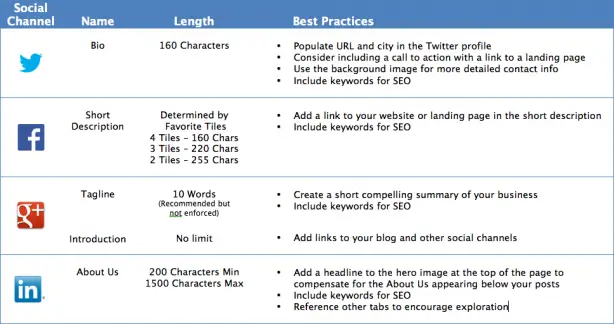
Facebook gives you a few options: There’s a tagline bio that shows up on your main page, and then there’s an “About” page that has fields to include that tagline, as well as mission, company overview, and description (some of the fields will vary depending on how you’ve set up your page — personal or business). Be as straightforward as possible here, while using descriptive language that your prospective consumer would enjoy.
See Inman Next’s page. They’ve used trigger words like “smart” and “opinionated,” which are aspirational qualities followers can identify with, and they’re expressing to the reader that by following, they’ll have access to useful and actionable information.

Valeria Garcia, Sr. Technology Coach for RE/MAX, offers an inviting view into her commitments and accomplishments, but also offers a value proposition to hook readers: “My training sessions are both informative and fun!”
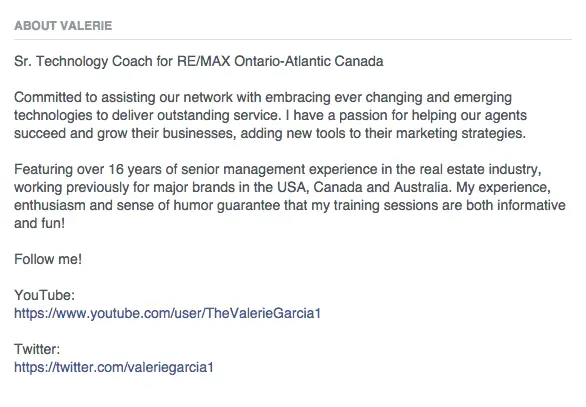
This is the best place for to-the-point information: your title, accomplishments, interests, and a bit of humor and personality.
MarketingProfs’s Ann Handley is “waging a war on mediocrity in content.” Is she waging a real, physical war? No. But her language builds an interesting visual and hooks us in.

Hillary Clinton finds a great way to imbue humor into her bio (hair icon, pantsuit aficionado), and if she can do it, then it’s a friendly reminder that social media should be fun. “Glass ceiling cracker” is a great use of a short phrase to describe her ambition and setting new standards for women in the workplace.

Google+
Because this bio is tied to your Google account, it’s important that it has the greatest amount of relevant information, appropriate keywords and links, and contact information. Technically, your “About” page on Google+ has lots of areas to fill in, but for the purposes of creating your bio, we’ll focus on the “Story” section which includes:
- Tagline – essentially a brief description of who you are
- Introduction – the heart of your bio where you can say who you are, what you do, and what you care about
- Bragging Rights – your accomplishments, professional or personal
Bill Gassett does a great job outlining not only his title, but also recent accomplishments, areas of specialty, and what he enjoys. He also speaks in the first person, which makes it feel as though he’s talking directly to the reader. He adds a value proposition, links to his websites and blog, and provides multiple ways to reach out to him.
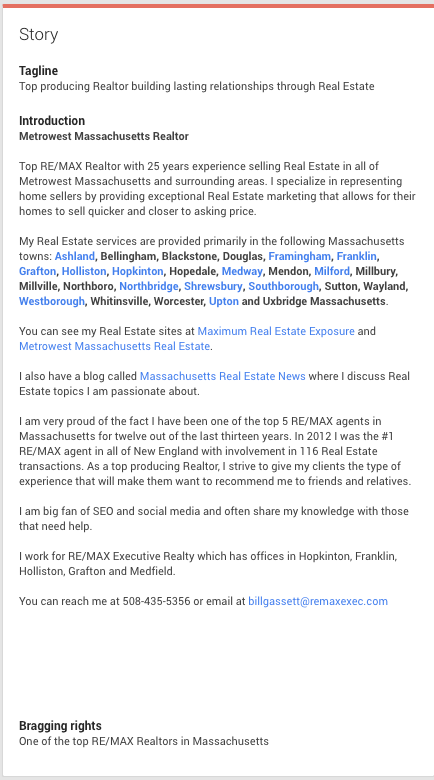
Blogger and marketing expert Jeff Bullas uses his bio to showcase his passion for all things digital, what he works on daily, and lists out his notable and very impressive accomplishments.
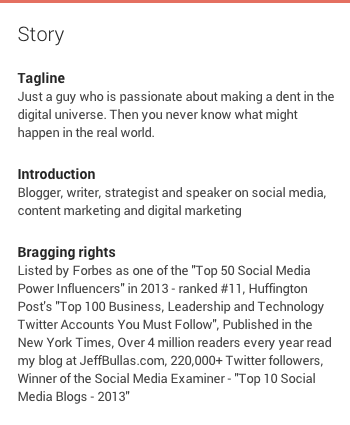
LinkedIn is the most professional networking social site, so it makes sense that your “Summary” would be the place to showcase accomplishments and experience in depth. And with no space restrictions, feel free to be as thorough as necessary to get the important details in.
Jason Miller of LinkedIn uses his bio to showcase his qualifications, accomplishments, and where you can find his published work.
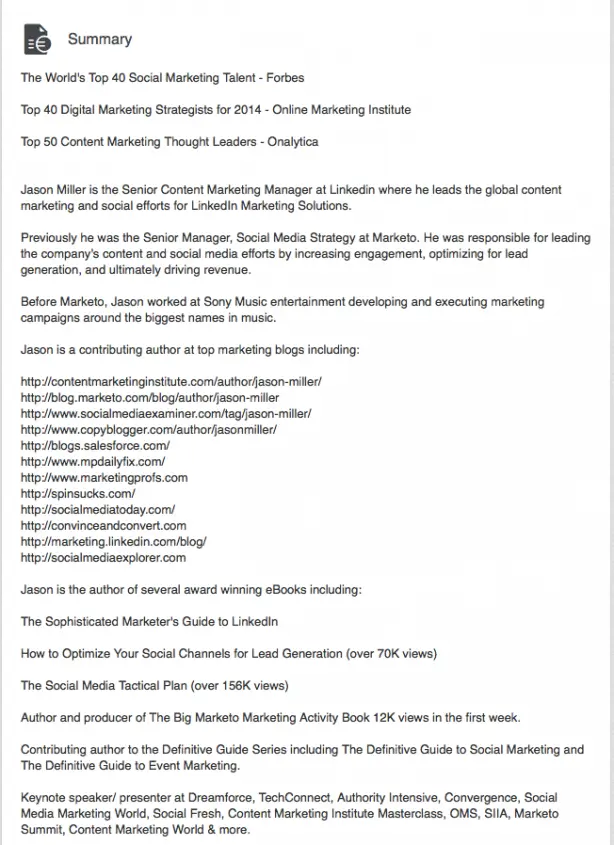
Andrea Goulet Ford of BrandVox offers us not just the bare essentials, but actual storytelling. She recounts her professional background (and passion for it), her specialties, and then uses her CTA to tell the reader to read through her content, as well as the value they’ll get when they do.
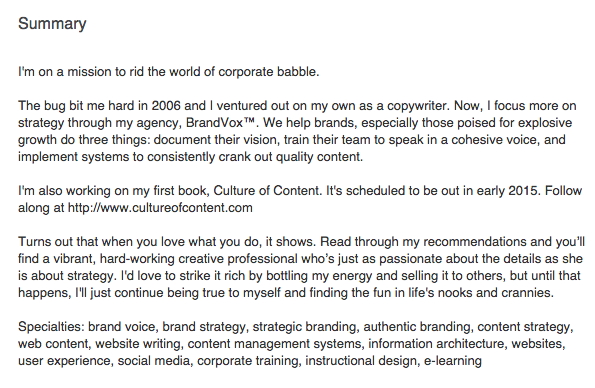
Your Pinterest bio is a great space for not just your business details: Being a visual medium, it’s also encouraged that you express your passions, creativity, and interests. Just remember that what you express here should also take form as boards in some capacity.
Lynn Pineda gives you everything you’d need to know about her in the most concise way. We know about about her personal life, what she does professionally, and what to expect from her boards. Notice how she also uses phrasing like “Hope to captivate you” in her CTA.

Angela Batchelor offers her expertise in her area, coining herself the go-to-gal, and also gives us a peek at her personal life.




